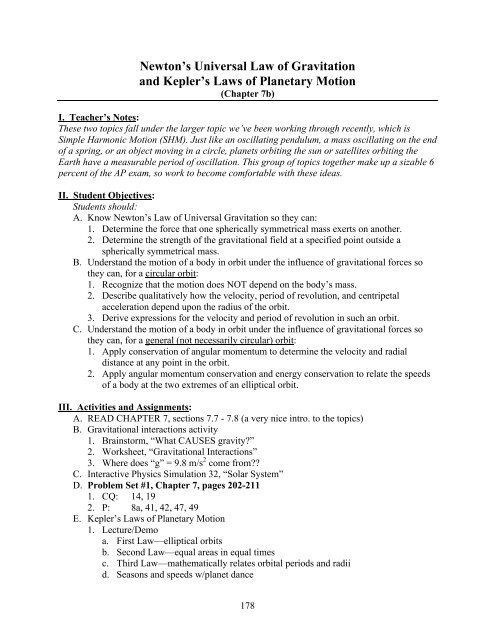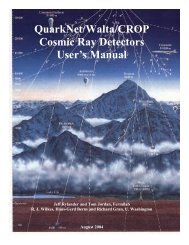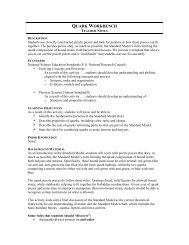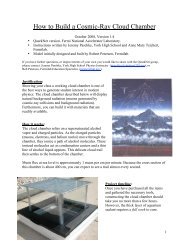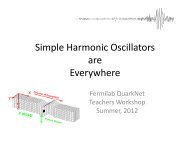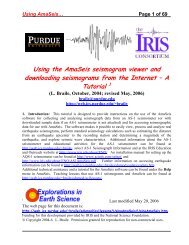Teaching Modern Physics - QuarkNet - Fermilab
Teaching Modern Physics - QuarkNet - Fermilab
Teaching Modern Physics - QuarkNet - Fermilab
You also want an ePaper? Increase the reach of your titles
YUMPU automatically turns print PDFs into web optimized ePapers that Google loves.
Newton’s Universal Law of Gravitation<br />
and Kepler’s Laws of Planetary Motion<br />
(Chapter 7b)<br />
I. Teacher’s Notes:<br />
These two topics fall under the larger topic we’ve been working through recently, which is<br />
Simple Harmonic Motion (SHM). Just like an oscillating pendulum, a mass oscillating on the end<br />
of a spring, or an object moving in a circle, planets orbiting the sun or satellites orbiting the<br />
Earth have a measurable period of oscillation. This group of topics together make up a sizable 6<br />
percent of the AP exam, so work to become comfortable with these ideas.<br />
II. Student Objectives:<br />
Students should:<br />
A. Know Newton’s Law of Universal Gravitation so they can:<br />
1. Determine the force that one spherically symmetrical mass exerts on another.<br />
2. Determine the strength of the gravitational field at a specified point outside a<br />
spherically symmetrical mass.<br />
B. Understand the motion of a body in orbit under the influence of gravitational forces so<br />
they can, for a circular orbit:<br />
1. Recognize that the motion does NOT depend on the body’s mass.<br />
2. Describe qualitatively how the velocity, period of revolution, and centripetal<br />
acceleration depend upon the radius of the orbit.<br />
3. Derive expressions for the velocity and period of revolution in such an orbit.<br />
C. Understand the motion of a body in orbit under the influence of gravitational forces so<br />
they can, for a general (not necessarily circular) orbit:<br />
1. Apply conservation of angular momentum to determine the velocity and radial<br />
distance at any point in the orbit.<br />
2. Apply angular momentum conservation and energy conservation to relate the speeds<br />
of a body at the two extremes of an elliptical orbit.<br />
III. Activities and Assignments:<br />
A. READ CHAPTER 7, sections 7.7 - 7.8 (a very nice intro. to the topics)<br />
B. Gravitational interactions activity<br />
1. Brainstorm, “What CAUSES gravity?”<br />
2. Worksheet, “Gravitational Interactions”<br />
3. Where does “g” = 9.8 m/s 2 come from??<br />
C. Interactive <strong>Physics</strong> Simulation 32, “Solar System”<br />
D. Problem Set #1, Chapter 7, pages 202-211<br />
1. CQ: 14, 19<br />
2. P: 8a, 41, 42, 47, 49<br />
E. Kepler’s Laws of Planetary Motion<br />
1. Lecture/Demo<br />
a. First Law—elliptical orbits<br />
b. Second Law—equal areas in equal times<br />
c. Third Law—mathematically relates orbital periods and radii<br />
d. Seasons and speeds w/planet dance<br />
178


